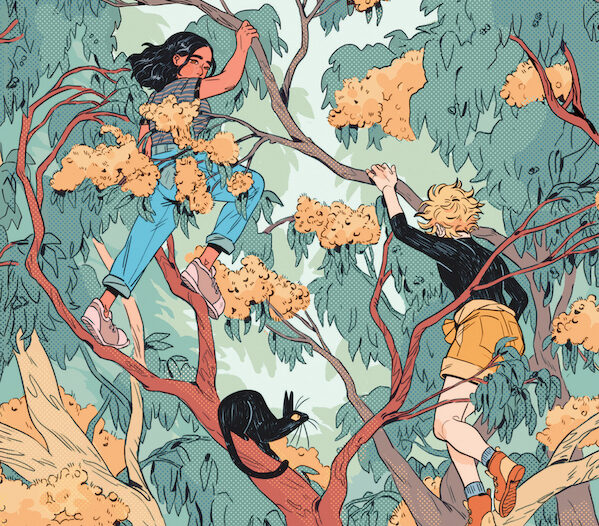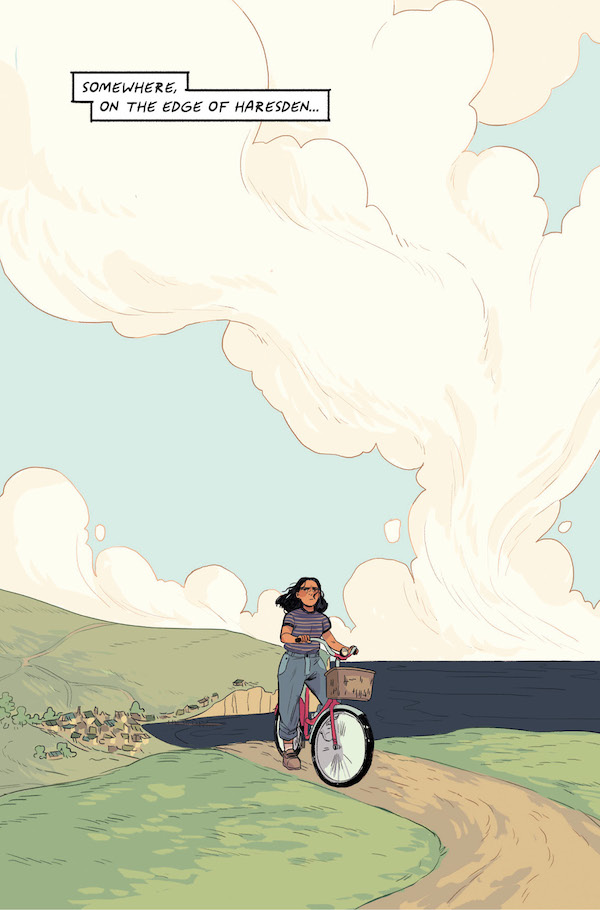
Shanti Rai Interviews Sas Milledge | Creators

Today we have a special treat: Two creators talking shop!

Shanti Rai is the creator of Sennen, a new middle-grade fantasy adventure graphic novel that was just published by Avery Hill on November 1. The story, rated for ages 10 and up, follows a young girl who must journey from the valley where she grew up to the home of the Gods themselves in order to save her family and community from disaster.
Sas Milledge is the creator of Mamo, a magical fantasy tale for ages 9 to 12 about a young hedge witch who has to set things right after the spirit of her late grandmother, a powerful hedge witch herself, is disturbed and starts causing trouble. It was published by BOOM! Box in April 2022.
ADVERTISEMENT
ADVERTISEMENT
In this interview, Rai talks to Milledge about creating a new world and filling it with stories of magic and emotion.
Shanti Rai: Mamo was such a compelling and fantastic read. I was completely enchanted whilst reading! I found myself completely lost in the gorgeous scenery of Haresden. Is Haresden based on a particular place? How did you come about creating the world?
Sas Milledge: Thank you so much! Yes, Haresden is based both generally on the landscape of the south east coast of Victoria, Australia, and specifically on Flinders, the town my parents live in, and where I spent much of my childhood. The landscape is important to the story of Mamo, so when designing the illustration style I was very conscious that I wanted there to be movement and life to them. That’s how I landed on the sweeping line-work and bright colours used throughout. Drawing on life and my own warm feeling towards the landscape that I grew up in helped me to bring it to life.

We see lots of different interpretations of family in this story, including the sweet interactions with Jo, her siblings & parents! From the honorifics Jo and her family use, they seem to have a Filipino background. I wonder if that was something that felt important to include in the story? Were any of the fantastical elements inspired by Filipino culture or folklore specifically?
Jo’s father is Filipino, yes! A dear friend of mine with Filipino-Australian heritage, Bon, helped me to bring that element of her background to life, alongside my incredible sensitivity reader Marie Soledad, who is explicitly responsible for the honorifics Jo and her sisters use in Mamo. Australia is a country made up largely of immigrants, with many from our neighbours in the Asia Pacific. Even though Haresden is fictional, its landscape and its people are based on those I grew up around, so including Jo’s heritage felt like a natural extension of that world. Much of the magic we see in Mamo is drawn from heritage, and specific to the user, so a lot of the magic we see is based on Orla’s background, which is Irish. As a result we don’t get to see much of what Jo’s magic would be like, but (spoilers!) I believe that as she develops as a witch Jo’s magic will, being specific to her, absolutely have Filipino influences.
There’s a strong tie between magic and emotion throughout Mamo. How did you balance the fantastical with the heavier topics of tradition, obligation and fear of stagnation?
I believe magic has always been a way for humans to explain the unexplainable, therefore extending that to those subtle and slippery problems felt very natural to me. I love fantasy that tries to answer questions about what in everyday life we consider mundane; as a different lens through which to look at our problems. That is what I hoped to do in writing Mamo, so bringing the two together was less of a balancing act than it was finding ways they could fit together, and in doing so tell a bigger story than they could apart.

Your style is really gorgeous! It captures movement in a way that makes the characters and places seem to jump off the page. How did you develop your personal style? Has anyone influenced you?
Thank you! I believe style is something that develops when you’re not looking, so it wasn’t an especially conscious thing. I trained as an animator, so I think a lot of the movement and expression I strive for in my work comes from that. As an extension of that many of my early influences are from animation, particularly Studio Ghibli and Avatar: the Last Airbender. In comics these days I find myself really taken with everything Jillian Tamaki does, as well as Hana Chatani, and Linnea Sterte. Story-wise my favourite writers are David Mitchell and Ursula K. Le Guinn.

As a fellow illustrator I know that there are good days and bad days when it comes to drawing! I’d love to know what your favourite thing was to draw whilst creating Mamo! Is there anything you struggled with?
I love drawing characters, so that never got old for me, and I love to design environments so every time I got to set up a new scene I always had fun. I did however get sick of drawing trees, I must admit.
What’s your creative process like? With such a complex and detailed story, how did you go from initial idea to the finished book?
My creative process comes in fits and bursts, particularly for writing. I began writing what would become Mamo in 2015, while on a trip to New Zealand. I find travelling a good time to write, as my head is usually empty of obligation and ready for new ideas to wander through. Artwork is a much more stable process for me, I know how to sit down and draw, regardless of whether I feel like doing it, so that’s a much steadier and work-intensive process. Each process requires a really different headspace for me, so I don’t have a lot of perspective on the piece as a whole until it’s finished. As a result I need to have a lot of faith that when I’m in one phase, the other will hold up its end of the bargain, and vice versa.

As someone who is deathly afraid of moths, the moth seemed like the perfect familiar & representation of Mamo! Is there a reason you chose moths? Also, we don’t get to see Jo choosing her familiar, but do you have an idea of what hers would be? What would yours be?
ADVERTISEMENT
ADVERTISEMENT
The irony of Mamo’s moth familiar is that I love moths, and have one tattooed on my ankle! However the reason I like them, and why they felt like the right choice for Mamo is because they’re so mercurial. Transformation and change is inherent to them, and yet they also represent decay and consumption (I’ve lost so many good jumpers to the little buggers). They are attracted to light, yet they’re nocturnal. This quality is an important part of how I wanted to represent Mamo, too. She is not evil, but she is also not good. She is a ghost, and a projection of Orla’s mind, but she is also a real and physical threat to Haresden. Also, moths look really cool.
As for Jo’s familiar, I feel like there’s an easter egg in the book that answers this. Part of Orla coming to realise she has underestimated Jo is when she learns Jo is friends with Caractus, which is a particularly witchy thing to do. Whether it’s Caractus or another currawong, I firmly believe Jo’s familiar is a bird. If I could have a familiar I think it would absolutely be my dog, Bobby. (Who has a cameo in the book as Jo’s uncle’s sheepdog!)

Queer stories and magic seem to go hand in hand. The way Orla & Jo end up bound by more than just magic was such a sweet and happy ending! Are there any other queer books or comics that you have loved and would recommend?
A queer magical comic I absolutely recommend is Ariel Slamet Ries’ Witchy!
I can’t wait to see what comes next from you! Do you have any upcoming projects that you’re excited about?
Thank you so much! I am currently working on an adaptation of Maggie Stiefvater’s The Raven Cycle with Stephanie Williams, which I feel like dovetails with the themes and ideas of Mamo really well, so I’m really excited about that. Otherwise I have a million other original ideas I’m trying to get my ducks in a row about, we’ll see!
Filed under: Graphic Novels, Interviews
About Brigid Alverson
Brigid Alverson, the editor of the Good Comics for Kids blog, has been reading comics since she was 4. She has an MFA in printmaking and has worked as a book editor, a newspaper reporter, and assistant to the mayor of a small city. In addition to editing GC4K, she is a regular columnist for SLJ, a contributing editor at ICv2, an editor at Smash Pages, and a writer for Publishers Weekly. Brigid is married to a physicist and has two daughters. She was a judge for the 2012 Eisner Awards.
ADVERTISEMENT
ADVERTISEMENT
SLJ Blog Network
Name That LEGO Book Cover! (#53)
Cover Reveal and Q&A: The One and Only Googoosh with Azadeh Westergaard
Fighting Public School Book Bans with the Civil Rights Act
Take Five: Middle Grade Anthologies and Short Story Collections
ADVERTISEMENT







